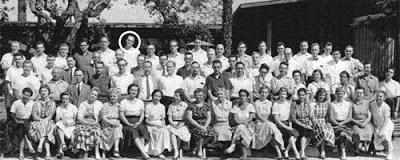 (1958-59 class of Fellows at Center for Advanced Study in the Behavioral Sciences; link)
(1958-59 class of Fellows at Center for Advanced Study in the Behavioral Sciences; link)
Sometimes the rubric "behavioral science" is used to capture some of the research areas of fields like sociology, anthropology, political science, and social psychology. In some ways this usage is no more than an administrative convenience, a way of grouping disciplines into schools. But the phrase has implications beyond this that are worth highlighting.
First, what does the label mean? We might paraphrase the idea as "the scientific study of human behavior in social settings". This definition emphasizes the social dimension of action, but it focuses on the behavior rather than the context.
Choosing this rubric rather than its companion, "social science," suggests a shift of emphasis from the social setting (structures) to the actual behavior of the individual actors. Are there patterns we can identify in the ways people behave in various specified settings? And since the 1950s the expression has been used to focus on the processes of cognition and decision-making that underlie the individual's activities in the world. So cognitive science and fields making use of rational choice theory have often been included within the umbrella as well. Herbert Simon's work plays a central role in this aspect of the field ("Theories of Decision-Making in Economics and Behavioral Science"; link).
This is the "behavioral" part of the label. What about "science"? This part of the label brings along a set of implications about the nature of the studies encompassed: measurement, prediction, precision, statistical generalizations and patterns. These are positive valences or connotations for a variety of purposes, including the goal of gaining significant funding for research. But they also appear to give lower priority to the ideas of theory and hypothetical entities and the messy complexity of large sociological theorizing; the implication is that behavioral sciences are solidly empirical and observational, whereas the social sciences are "soft science".
Is this a helpful move? Yes and no. In its favor, the label pushed forward a particular agenda of research into the underlying components of social action. But it also served to suggest that the methods of other areas of the "social" sciences were not quite up to snuff.
One of the most prominent locations for "behavioral science" research in the United States is the Center for Advanced Study in the Behavioral Sciences at Stanford (link). The Center was established as one of the first major investments of the Ford Foundation in 1954. Leading scholars helped to found the Center: Robert Merton, Paul Lazarsfeld, Donald Marquis, Ernest Hilgard, Herbert Simon, Bernard Berelson, and Ralph Tyler. Here is a revealing gloss on the nomenclature contained on the website: "It wasn't too great a leap then to assume that we needed a social science, or behavioral science (the term coined and preferred by Ford as a means of disassociating the enterprise from socialism and even communism that were so under attack at the time) to solve our major problems." This comment illustrates the "scientific politics" that surround the development of disciplines and fields of research in the social sciences.
So there is some reason to think that the nomenclature of "behavioral science" serves a scientific-political purpose: to direct American social science research in a particular set of directions, and to discourage research that extends in more theoretical, comparative, and "macro" directions.
An interesting set of essays that try to make sense of the idea of "cold war social science" is provided in Mark Solovey and Hamilton Cravens, Cold War Social Science: Knowledge Production, Liberal Democracy, and Human Nature (2012). The volume maintains a degree of distance from the idea of "cold war social science", but some of the contributors highlight the forces that were at work in the funding and institutions of the social sciences that created a degree of alignment between social science research and national security. Particularly interesting is Hamilton Cravens' contribution, "Column Right, March! Nationalism, Scientific Positivism, and the Conservative Turn of the American Social Sciences in the Cold War Era". Here is the publisher's description of the volume as well as the table of contents; link.
